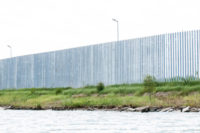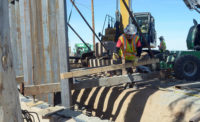Privately-funded sections of U.S.-Mexico border wall built in New Mexico and Texas came under scrutiny again Aug. 20 when four officials of a wall fundraising group, We Build the Wall, were indicted on fraud charges for tapping the $25-million donor fund for personal use. The indictment notes involvement of an unnamed construction contractor in the fund-tapping scheme, but that contractor was not indicted.
Among the four indicted by the federal prosecutor in New York City and arrested was Steve Bannon, former chief strategist to President Donald Trump. He and the others were released on bond.
Audrey Strauss, acting U.S. Attorney for the Southern District of New York, and Philip R. Bartlett, inspector-in-charge of the New York field office of the U.S. Postal Inspection Service, announced the unsealing of an indictment.
Brian Kolfage, the Iraq War veteran who began We Build the Wall, was charged by federal prosecutors with conspiracy to commit fraud by taking more than $350,000 for his personal use from the crowdfunded total, some of which has been used to build non-federally built border wall segments in Sunland Park, N.M. and in Mission, Texas.
North Dakota contractor Fisher Sand & Gravel built both of those barriers, with the New Mexico wall using about $9 million in We Build the Wall funding and the one in Texas gaining about $2 million from the group. That estimated $40-million project also involved other private funding.
Fisher was not indicted and said in a statement that it has no other projects with We Build the Wall.
The firm also is one of a number of contractors selected for federal wall building, winning three major contracts from the US Army Corps of Engineers and the US Dept of Homeland Security since the end of last year, totaling nearly $2 billion.
Bannon Tapped $1 Million
Bannon received more than $1 million from We Build the Wall, which he used for personal expenses and to pay Kolfage, according to the 23-page indictment filed in New York City because some funds were raised there.
Kolfage also was paid through a nonprofit and a shell company using fake invoices and fake vendor arrangements.
Kolfage, Bannon and two others were indicted for carrying out a scheme to defraud hundreds of thousands of donors to the effort that sought to pay for wall building, a Trump campaign pledge that Congress would not finance in its entirety.
Those indicted repeatedly misled donors in a crowd-funding effort by promising that 100% of funds would be used for construction, says the indictment. Prosecutors are seeking to recoup funds and property traceable to the fraud.
The private wall segments completed are not connected to the federal border wall.
The Corps of Engineers has told ENR it is not involved in land acquisition or project delivery related to the private wall segments, although Homeland Security in June issued a request for information on how to incorporate private wallbuilding activity on 30 border segments totaling up to 250 miles.
Kolfage said on a Bannon-run podcast last month that the department provided We Build the Wall with a list of border wall projects "where they wanted us to plug little holes," according to a Texas Tribune report.
The unnamed construction contractor, referred to as “associate-1” in the indictment, was paid $150,000, and in turn paid $70,000 to Kolfage and $50,000 to Andrew Badolato, a Bannon business partner who also was charged in the conspiracy along with Timothy Shea, a conservative commentator. The hree men and Bannon also are charged with money laundering.
When questioned by reporters after the indictment was unsealed, President Trump said he had no involvement with the project and that it was inappropriate to build a private wall. He called it “showboating."
Trump termed "inferior" the 3.5-mile wall in Texas that Fisher completed earlier this year on the Rio Grande riverbank that authorities say already has shown signs of erosion and instability. Fisher has indicated that repairs are underway.
“I disagreed with doing this very small (tiny) section of wall, in a tricky area, by a private group," he said, adding that it "should have been built like the rest of the wall."
Last year, Trump lobbied for the Corps of Engineers to award a $400 million federal contract to Fisher Sand & Gravel. That award was made last December, but is under an ongoing Defense Dept. Inspector General audit sought by Congress.
Officials of the two agencies have "raised concerns" about hiring Fisher, according to the Washington Post, in an Aug. 20 report, but neither agency responded to a request from ENR to outline those concerns.
A Corps spokeswoman said she could not comment on current litigation.
Javier Pena, an attorney for a private sanctuary adjacent to the Texas wall that has sued Fisher over claimed wall impact to its property, says the two sections of private barrier built on the border violated a treaty with Mexico that is overseen by the International Boundary and Water Commission.
A federal judge in Texas ruled, however, that We Build the Wall did not need commission permission for construction. Mexico opposed the border wall’s construction directly on the river fearing it would generate floating debris.
Pena is concerned that the international treaty violatoin sets precedent for Homeland Security to waive it, which ultimately paved the way for an Aug. 5 solicitation by the Corps for interest from contractors and manufacturers to build a “buoy barrier system,” or floating border wall, for use along the southern border.
Responses were due Aug. 19, but the Corps referred ENR’s request for the number of submissions it received to DHS, which did not respond by press time.






Post a comment to this article
Report Abusive Comment